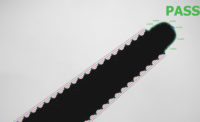The introduction of the digital optical comparator has provided manufacturers across a wide range of industries with a number of benefits over traditional optical comparators for the inspection and measurement of manufactured parts directly on the shop floor. Some of the most significant benefits include the following:
- The ability to compare a part directly to its CAD data, without the need for a Mylar, template or overlay.
- Increased accuracy (due to optical improvements, the system carries out a direct-to-CAD comparison as well as to numerous computational improvements).
- Increased throughput (due to the very nature of this digital system which provides many information management benefits).
- The ability to capture complete electronic documentation (including a high-resolution image of the part with its CAD overlay, measurements and statistics).
Recently, the capabilities of the digital optical comparator have expanded to provide even more unique benefits over the traditional optical comparator. The two most noteworthy are the ability to:
- Compare large parts to their CAD data, retaining full accuracy
- Fully automate inspection operations, even in the case of complex inspection and measurement criteria
Extended Travel Systems
With a traditional optical comparator, the operator can only compare the part to its Mylar in one field-of-view at a time. Let’s consider a numerical example: in the case of a 30-inch optical comparator with a 10X magnification, the dimension of the field-of-view is three inches (i.e. three inches times the 10X magnification equals the 30-inch diameter of the projection screen). This means that a three-inch part can be viewed and inspected all at once and that a six-inch part needs to be inspected in two steps, with a manual displacement in between. There is, of course, the possibility of an error associated with these manual displacements, so the part length that can be accurately inspected on a traditional optical comparator is limited. To ensure accuracy, traditional optical comparators have short travels (generally 12 inches or less).
TECH TIPS
|
However, in the case of the digital optical comparator, the CAD data tracks the part (i.e. the CAD moves with the part as the stage travels) using the stage’s encoder feedback. As a result, it is possible to compare a part to its CAD data across the entire stage travel, without incurring any type of incremental error. Because there is no incremental error, there is no reason to limit the stage’s travel. This has led to the recent development of very long travel systems that now allow manufacturers to inspect large parts.
Power generation is a good example of an industry that benefits tremendously from this breakthrough. Large land-based turbine blades can now be compared very accurately to their CAD data across their entire length. Historically, only a small portion of these large parts was inspected due to the limitations using traditional optical comparators. For example, on this type of comparator only the turbine blade’s fir tree was verified, either independently of the rest of the part or with the rest of the part assumed to be within tolerance.
CAD Auto-Align and CAD Auto Pass/Fail
Another great advantage of the digital optical comparator over traditional optical comparators is in its inherent capability: the fact that it is digital means that an image of the part resides in computer memory. Advanced image analysis computations can thus be carried out on this digital image, enabling the digital comparator to carry out advanced operations that were previously carried out by the operator, specifically the alignment of the CAD to the part as well as the comparison of the part to its CAD data. With the traditional optical comparator, these operations were carried out manually and typically had a significant amount of operator-to-operator variation. With the digital optical comparator, these operations can now be carried out automatically. These new tools, called CAD auto-align and CAD auto pass/fail, completely eliminate operator-dependent variation and are also much faster, producing results that are more accurate, typically by an order of magnitude (10X) or more.
Recently developed algorithms allow the digital optical comparator to carry out CAD auto-align operations in a number of different ways to accommodate a wide range of application requirements including along the X and the Y axes, either individually or simultaneously, rotational alignment alone, or full X, Y and rotation alignment of the CAD to the part. These high-accuracy operations are extremely fast; even the most involved CAD auto-align step can be completed in one or two seconds, at most. This flexibility allows the tool to align the CAD along either one or multiple datums or to carry out an overall best fit, allowing the system to meet a very wide range of inspection and measurement criteria.
In parallel with this, powerful and flexible CAD auto pass/fail algorithms have also recently been developed to allow very fast and accurate part-to-CAD comparisons. These advanced algorithms are very flexible and support different schemes that can carry out inspections which are either point-based or that consider complete geometric entities. And adapted filtering schemes have been developed to give the system the ability to disregard spurious defects (such as chips on metal parts) as well as dust and contamination, all of which would otherwise lead to false-rejects.
The very general-applicability of all of these recently introduced features allows the digital optical comparator to tackle even the most demanding applications. A good example is the inspection and measurement of flexible automotive seals (such as door trim, weather seals, etc.). These parts are notoriously difficult-to-inspect for a number of reasons, including the following:
It is not uncommon that a flexible automotive seal part requires inspection using many different datum sets (sometimes six or seven or more). With a traditional optical comparator, this requires that the operator realign the Mylar every time (in our example: six or seven realignments per part). This results in an extremely lengthy inspection with highly operator-dependent results. The digital optical comparator is the ideal solution for these parts as it can carry out all of the alignments and inspections automatically with great repeatability and accuracy, all in a matter of seconds.
These extruded rubber parts are very flexible and subject to lots of part distortion. The inspection criteria that have been developed in this industry to deal with such part variability are quite unusual. For example: sometimes an entire length of the part must fall within a tight tolerance band, and at other times it is only required that any portion of the part be present inside a region. The digital optical comparator is a comparative measurement system with advanced algorithms allowing it to meet these challenging inspection and measurement criteria.
Some of these parts need to be inspected in a fixtured position and others in a free, or unfixtured, position. These widely varying conditions can pose many challenges for measurement systems. The digital optical comparator, as a comparative measurement system with many advanced computational tools, has the flexibility required to successfully solve such demanding applications with wide-ranging conditions.
Compared to the traditional optical comparator, the digital optical comparator uses a completely different approach and is built on more up-to-date technology. This facilitates advancing and expanding digital optical comparator technology to a considerably broader range of applicability, now including much longer parts, as well as fully-automated part-to-CAD comparison. These benefits are advantageous to manufacturers across a wide range of industries that need to check their parts quickly and accurately directly on the shop floor.





